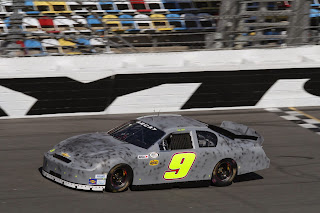 |
| Elliott (L) before the fall |
For approximately 30 minutes Sunday night, Chase Elliott
was the undisputed king of short track stock car racing.
Elliott, son of former NASCAR Winston Cup Series champion
Bill Elliott and himself an insanely talented wheel man, became the first
driver in history to win the prestigious Snowball Derby at Florida’s Five Flags
Speedway, after prevailing in the previous day’s Snowflake 100 Pro Late Model
event.
And then, it all came apart.
A post-race technical inspection revealed a piece of
tungsten ballast attached to the chassis of Elliott’s machine, and with tungsten
expressly prohibited in the Snowball Derby rules -- in BOLD FACE TYPE – the violation cost Elliott both his trophy
and $20,000 winner’s purse.
The disqualification triggered an immediate firestorm of
controversy, with some observers questioning whether the infraction was serious
enough to warrant stripping Elliott of the win. Others rode to the young driver’s
defense, saying he likely had no knowledge of the illegal ballast and
supporting his claim that the violation was little more than an oversight.
None of that matters to me, and here’s why.
In racing, some things are illegal because they give a
performance advantage. Some are illegal because they are too costly. Some are
illegal because they compromise safety. No matter what, they're all illegal,
and in my opinion, that should be the end of the story.
 |
| The offending tungsten. (Speed51.com) |
I don’t buy the whole, "it was illegal, but it
didn't give me an advantage" argument, and neither should you. It's a
cheap cop-out used by guys who have just gotten caught with their
hands in the cookie jar. The argument that tungsten ballast offers no
competitive advantage is also ludicrous, on a number of counts.
In many race cars, ballast is
inserted into chassis frame rails in blocks that are approximately 2 5/8 inches
x 3 5/8 inches. In that configuration, a 25- pound block of tungsten measures approximately
3.75″ long, while 25 pounds of lead is nearly 6.5″ long. Concentrating more weight in less space allows more
precise chassis adjustment, and in a division where left-side weight percentage
is regulated with a fine-toothed comb, there is no such thing as an
inconsequential advantage. Roll center
and center of gravity can also be more precisely set with tungsten than lead,
giving teams even more of a handling edge.
If it truly offers no competitive edge, why would NASCAR Sprint Cup and
Nationwide teams with unlimited budgets spend thousands of dollars on tungsten
ballast? Clearly, they understand that there’s something important to be
gained. If it wasn’t better, it would not have been on Chase Elliott’s car. Bet
on that.
Here’s another point to ponder.
Racers fail post-race inspections all the time, for a
wide variety of reasons. Some of infractions are fairly minor, while others are
more blatant. Each of those nefarious deeds, however, was undertaken for one
simple reason: to make the race car faster.
 |
| Not fancy, just effective. |
When was the last time you heard of someone getting caught
doing something illegal that made their car worse? Never, that’s when!
And there’s a good reason for that.
I was not at Five Flags Speedway Sunday, and I know
little or nothing about the specifics of Chase Elliott’s violation. But I'll bet
dollars against donuts that the tungsten ballast in question was mounted low
and to the left, rather than high and right. It was mounted there for
a reason, and it did what it was intended to do. Big advantage or small, nothing
on these race cars happens by mistake.
Some argue that in a Snowball Derby pit filled with $200,000 transporters, a
few thousand dollars in tungsten is hardly the end of the world. That may be
true, but not one of those high-dollar Toterhomes ever won a race. It may make its
owner more comfortable getting to the track, but it does nothing once the green
flag flies.
Teams don't need a fancy hauler to compete. My Super Late
Model team gets to the track in a modest, 24-foot box trailer pulled by a Ford
F350 dually. It’s nothing fancy, but it gets us where we’re going every week,
while leaving us a little more money to spend on our race car.
The problem with a high-buck item like tungsten is that once somebody has it, everybody’s
got to have it if they hope to keep up. If I suddenly have to spend $20,000 on
ballast for my race car -- instead of melting down used wheel weights
from the tire store -- it's going to dramatically hasten my exit from the
sport.
Nobody can prevent a rich man from spending his own money.
But race tracks and sanctioning bodies can -- and should -- prevent him
from spending his money in ways that diminish competition or break the
rules. Elliott’s car had an advantage, and it was illegal.
It’s as simple as that.























